Intel’s Silvermont Architecture Revealed: Getting Serious About Mobile
by Anand Lal Shimpi on May 6, 2013 1:00 PM EST- Posted in
- CPUs
- Intel
- Silvermont
- SoCs
ISA
The original Atom processor enabled support for Merom/Conroe-class x86 instructions, it lacked SSE4 support due to die/power constraints; that was at 45nm, at 22nm there’s room for improvement. Silvermont brings ISA compatibility up to Westmere levels (Intel’s 2010 Core microprocessor architecture). There’s now support for SSE4.1, SSE4.2, POPCNT and AES-NI.
Silvermont is 64-bit capable, although it is up to Intel to enable 64-bit support on various SKUs similar to what we’ve seen with Atom thus far.
IPC and Frequency
The combination of everything Intel is doing on the IPC front give it, according to Intel, roughly the same single threaded performance as ARM’s Cortex A15. We’ve already established that the Cortex A15 is quite good, but here’s where Silvermont has a chance to pull ahead. We already established that Intel’s 22nm process can give it anywhere from a 18 - 37% performance uplift at the same power consumption. IPC scaling gives Silvermont stable footing, but the ability to run at considerably higher frequencies without drawing more power is what puts it over the top.
Intel isn’t talking about frequencies at this point, but I’ve heard numbers around 2 - 2.4GHz thrown around a lot. Compared to the 1.6 - 2GHz range we currently have with Bonnell based silicon, you can see how the performance story gets serious quickly. Intel is talking about a 50% improvement in IPC at the core, combine that with a 30% improvement in frequency without any power impact and you’re now at 83% better performance potentially with no power penalty. There are other advantages at the SoC level that once factored in drive things even further.
Real Turbo Modes & Power Management
Previous Atom based mobile SoCs had a very crude version of Intel’s Turbo Boost. The CPU would expose all of its available P-states to the OS and as it became thermally limited, Intel would clamp the max P-state it would expose to the OS. Everything was OS-driven and previous designs weren’t able to capitalize on unused thermal budget elsewhere in the SoC to drive up frequency in active parts of chip. This lack of flexibility even impacted the SoC at the CPU core level. When running a single threaded app, Medfield/Clover Trail/et al couldn’t take thermal budget freed up by the idle core and use it to drive the frequency of the active core. Previous Atom implementations were basically somewhere in the pre-Nehalem era of thermal/boost management. From what I’ve seen, this is also how a lot of the present day ARM architectures work as well. At best, they vary what operating states they expose to the OS and clamp max frequency depending on thermals. To the best of my knowledge, none of the SoC vendors today actively implement modern big-core-Intel-like frequency management. Silvermont fixes this.
Silvermont, like Nehalem and the architectures that followed, gets its own power control unit that monitors thermals and handles dynamic allocation of power budget to various blocks within the SoC. If I understand this correctly, Silvermont should expose a maximum base frequency to the OS but depending on instruction mix and available TDP it can turbo up beyond that maximum frequency as long as it doesn’t exceed TDP. Like Sandy Bridge, Silvermont will even be able to exceed TDP for a short period of time if the package temperature is low enough to allow it. Finally, Silvermont’s turbo can also work across IP blocks: power budget allocated to the GPU can be transferred to the CPU cores (and vice versa).
By big-core standards (especially compared to Haswell), Silvermont’s turbo isn’t all that impressive but compared to how things are currently handled in the mobile space this should be a huge step forward.
On the power management side, getting in and out of C6 should be a bit quicker. There's also a new C6 mode with cache state retention.


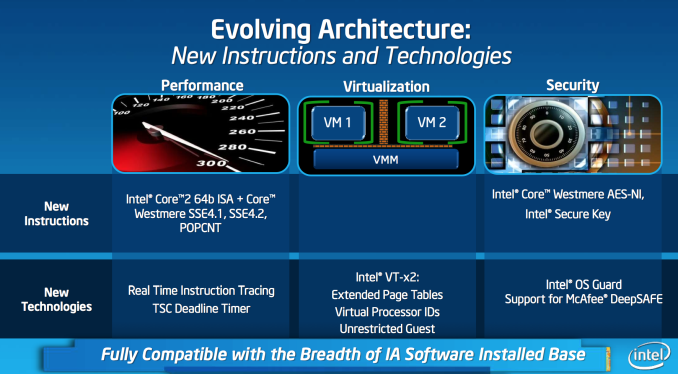
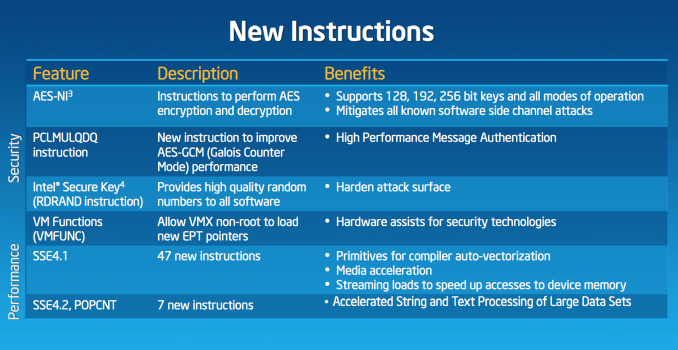
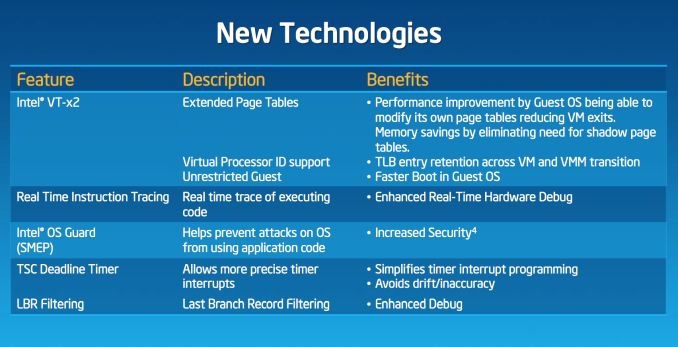
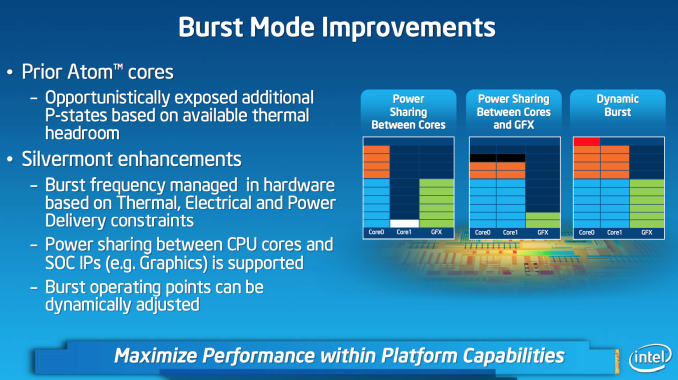
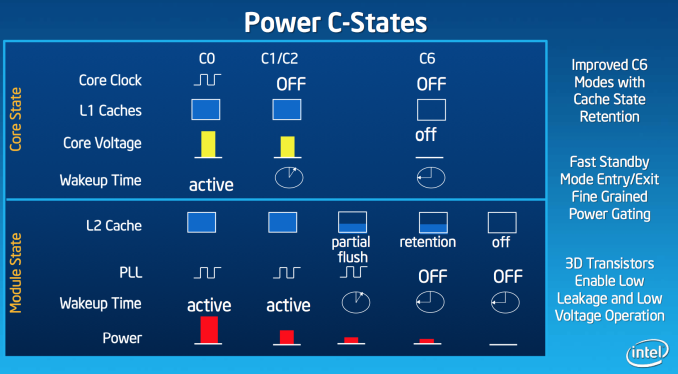








174 Comments
View All Comments
Spunjji - Wednesday, May 8, 2013 - link
+1chubbypanda - Monday, May 6, 2013 - link
The article is about yet to be relased platform. Obviously you could get better information if you work for Intel or its OEM partners. If you don't, Anand's writing is as good as they get.Thrill92 - Tuesday, May 7, 2013 - link
But what's your point?raptorious - Monday, May 6, 2013 - link
It seems like every subsequent Anandtech article about Intel that I read sounds more and more like an Intel Marketing slide deck. I think I'd believe that the absolute performance of Silvermont is better than Cortex A15, but I'm very skeptical that the perf/watt will actually be better at the TDP that we care about for a tablet. I have a very hard time believing that a 2-wide OoO architecture will get better IPC than a 3-wide one. In order to achieve better performance, you'd have to very aggressively scale frequency, and as we all know, perf/watt usually decreases as you scale frequency up (C*V^2*F). It MIGHT be better perf/watt in a phone, simply because with a 2-wide architecture, you can scale dynamic power much lower, but of course, then you can't make the ridiculous claims of 1.6x performance.JarredWalton - Monday, May 6, 2013 - link
FWIW, Intel is willing to provide these detailed slide decks long in advance of the launch of their hardware. The other SoC vendors are far less willing to share information. If Apple, Qualcomm, or some other vendor put together a nice slide deck, I can guarantee we'd be writing about it.B - Monday, May 6, 2013 - link
@JarredWalton, I completely agree with your assessment. I have listened to every Anandtech Podcast and repeatedly hear Anand and Brian Klug lament the lack of transparency with the other SOC vendors. Those two go through great lengths to get any meaningful information on the roadmaps of Apple, Qualcomm, et al. The bottom line is that currently Intel is accustomed to sharing more information than its peers in the mobile industry and I suspect your readership wants to know what's coming long before the product is released, and this will always include a speculative component.beginner99 - Monday, May 6, 2013 - link
The intel slides basically say intel will have 8x better performance/watt. Now if you don't believe them, just half the numbers and you are at 4x, which is still huge...I believe it.Medfield uses a basically 5 year old design on an older process!!! than current ARM offerings and is competitive in performance/watt (it's actually better already). The only thing is how efficient the GPU will be and even more important how expensive the whole SOC will be. So even if the performance and power data is correct, not guarantee it will succeed.
I do see why some don't like the article but I think Anand is just enthusiastic and lets be honest, AMD has no delivered anything to be enthusiastic about in years and has a history of misinformation on slides What intel disclosed on slides was usually more or less true in the past so they have more credit than AMD.
raptorious - Monday, May 6, 2013 - link
Showing 8x perf/watt or even 4x perf/watt from generation to generation might be possible by milking numbers, but across the board that is laughably impossible. You're talking about defying the laws of physics. This architecture isn't radically different from A15 or other designs, and the process improvements of 22 nm over 32 nm don't just magically give you 4x perf/watt. If you want to live in Intel's fairy tale land, go ahead.JDG1980 - Monday, May 6, 2013 - link
Intel has far better fabs than anyone else. That alone gives them a huge advantage. The reason they've been doing so poorly up until now is that (as the article mentions) they've basically been stagnating with an Atom design dating back to 2004. Now that they've updated to a modern design, they should be able to beat their competitors decisively on the hardware side. Whether that will lead to design wins or not, who can say... they're pretty late to this particular game. But they can give it a good shot.t.s. - Tuesday, May 7, 2013 - link
Yeah, right. Same with AMD. After they 'upgrade' their architecture from star to bulldozer, they automagically have a huge advantage. Remember, changing architecture doesn't necessary a good thing. Moreover for the 1st time you do the change.